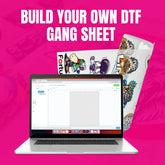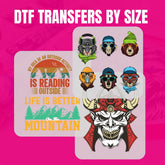How to Make DTF Transfers at Home: A Step-by-Step Guide
Printing custom designs onto fabric has never been easier, thanks to DTF transfers. Learning how to make DTF transfers at home will provide countless opportunities regardless of your desired level of entrepreneurship or simple need for customizing clothing. DTF, or Direct to Film, printing lets high-quality, long-lasting prints without requiring a costly setup unlike conventional screen printing. From the comfort of your house, you can produce professionally-grade designs with the correct tools at some time.
This guide will walk you through every stage, from designing to printing your work onto cloth. By then, you will have all the knowledge required to create your own DTF heat transfers and realize your artistic ideas.
What You Need to Make DTF Transfers at Home?
One should have all the tools and supplies before starting the operation. You will require a DTF printer, DTF transfer film, DTF ink, adhesive powder, and a heat press if you want to effectively generate DTF transfers. Achieving professional-quality prints without them is impossible. Given the heat and fine powders involved in the drying process, you should also have a well-ventilated area.
Step 1: Designing Your Artwork
Making your design comes first in learning how to create DTF transfers. To guarantee high-resolution photos, you will want graphic design tools such as Illustrator, CorelDRAW, or Adobe Photoshop. Your design should be in CMYK color mode for accurate color reproduction. Remember that printing on dark materials calls for white ink, so incorporate a white layer in your design configuration.
Make sure your artwork reflects back to you before printing. This is crucial since DTF transfers call for flips before application. The design will show reversed on the final cloth without mirroring. To maintain fine details, save your design in a high-resolution PNG or TIFF file.
Step 2: Printing on DTF Transfer Film
Printing comes time after your design is ready. You will require a DTF printing machine furnished with DTF ink. Unless adjusted for DTF printing, regular inkjet printers will not function. The method begins with filling the printer with DTF paper—PET film.
DTF printers apply a two-stage ink-laying technique. The CMYK colors print first, then a coating of white ink. The white ink serves as a basis, allowing any cloth to show the colors vividly. Making a DTF gang sheet will maximize efficiency and save film waste if you are printing several designs concurrently. Print, then let the ink sit for a few minutes to avoid smudging before continuing on to the next step.
Step 3: Applying Adhesive Powder
Applying hot melt adhesive powder comes next once the DTF transfer film prints. It is this powder that lets the design firmly stick to the cloth. Sprink lightly the sticky powder over the wet ink. Check that the powder covers the whole pattern uniformly. Shake off any extra powder then leave just a thin, equal covering. Should gaps exist, the design might not be able to migrate as intended. As the thin powder might readily disperse, make sure your workspace is dry and free of too strong airflow for optimal results.
Step 4: Curing the DTF Print
Before the design can be applied to cloth, the adhesive powder must be cured. This stage requires heat, which can be supplied by a heat press or curing oven. Set the temperature in a curing oven between 250°F and 300°F (120°C and 150°C), then heat for two to three minutes. The powder should glitter but not burn. Hover the heat press without directly pressing to cure the glue if you are using one. This curing process is crucial. If mistakes are made, the DTF heat transfers might not bind tightly to the fabric and might peel following washing.
Step 5: Transferring the Design onto Fabric
The interesting part is now copying your design into a cloth. To eliminate moisture and wrinkles, pre-press the cloth at 320°F (160°C) for five seconds before applying the DTF transfer film. This stage guarantees a homogeneous and smooth transmission.
Place the DTF transfer film on the ready fabric with the design facing down. Close the heat press and run medium pressure at 320°F (160°C) for 15 to 20 seconds. This lets the adhesive and ink really bond with the fabric's threads.
Step 6: Peeling Off the Film
Press, then let the fabric cool somewhat. The kind of DTF transfer film you use will define how you peel it off:
-
Hot Peel: Still warm, the film can be taken right away upon pressing.
-
Cold Peel: Before peeling, the fabric has to cool totally.
Peel gently and consistently to prevent ruining the print. Done well, the DTF transfer will feature fine details and vivid, brilliant colors.
Step 7: Final Press for Durability
Doing a last press will help to guarantee longer DTF heat transfers. Cover the design with a Teflon sheet or parchment paper, press once more at 320°F (160°C) for ten seconds. This increases durability and allows the ink to lock into the cloth. When correctly used and maintained, high-quality DTF transfers can resist over 60 washes without fading or cracking. This qualifies them as a great choice for companies specializing in personalized clothing.
Conclusion
Knowing how to create DTF transfers can help you begin designing vivid and long-lasting works right from home. Whether for a small business or personal usage, this approach provides reasonably priced bespoke graphic printing on several textiles. Using DTF paper, adhesive powder, and a DTF printing machine among other appropriate materials, you may create excellent prints spanning years.
Designing, printing, applying adhesive, curing, pressing, and peeling—you will become a master in DTF heat transfers. With correct treatment, these prints will stay bright and vibrant through several washes. Starting now will help you realize your creative ideas!
For more tips and resources on DTF transfers, visit DTF Transfer Art.
- bulk printing
- Custom clothing printing
- custom gangsheet
- decal transfer
- decal transfers
- Digital printing
- dtf transfer
- dtf transfer art
- dtf transfer film
- dtf transfer instructions
- dtf transfer paper
- dtf transfer sheets
- dtf transfers near me
- dtf transfers ready to press
- dtf transfers wholesale
- gangsheet printing
- heat transfer decals
- Printing companies
- Quality printing
- Transfer printing






